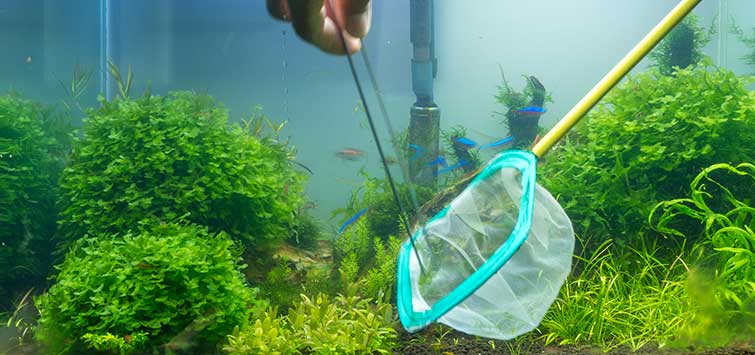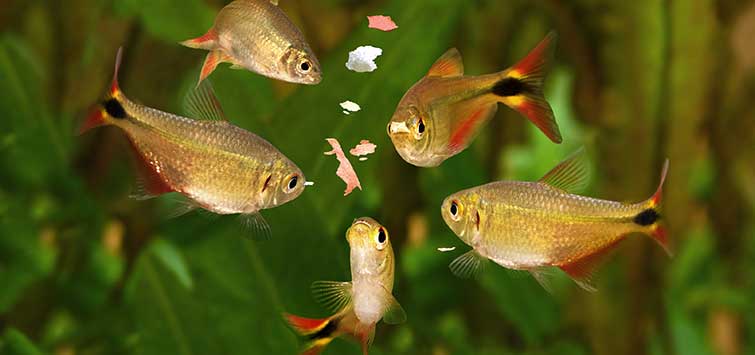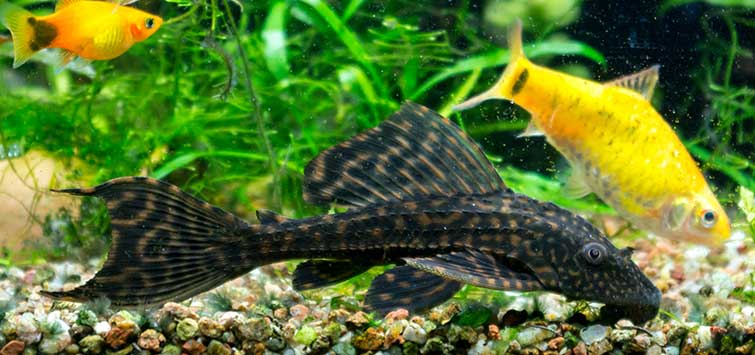Maintaining the Nature Aquarium
Author: Takashi Amano
Plant trimming and algae control are two of the main keys to keeping the Nature Aquarium layout healthy and beautiful over the long term.
In the Nature Aquarium, a layout is created by arranging rocks and driftwood and planting aquatic plants in a tank. However, the layout is not finished with this. An aquascape is complete only when aquatic plants are grown well. It takes a few weeks to a few months from the time that a layout is put together until a beautiful aquascape is finished. The fun of Nature Aquarium is in maintaining an aquascape thereafter for a year to a few years.
The following points are important for maintaining a layout for a long time. First, aquatic plants must grow healthy. Then the volume of multiplying plants needs to be controlled, and emerging algae must be eradicated.
Advice for Growing and Trimming Plants
As for growing healthy plants, I have in previous articles introduced the methods for building substrates (TFH July 2005), as well as proper lighting and CO2 supplementation (TFH December 2005). Aquatic plants grow well when they are provided with an environment for them to photosynthesize sufficiently and the necessary nutrients are provided.
As for the trimming of aquatic plants, I also have discussed the trimming method for the Nature Aquarium (TFH November 2005) in which the upper part of the aquatic plants are cut off with scissors, using the example of the stem plants which require trimming the most frequently. Although the trimming proper method to use depends on the type of plants, in the Nature Aquarium, as a general rule, the upper part of aquatic plants are cut off, leaving roots, the lower part of stems, and runners intact, and allowing new leaves to grow from the remaining parts of the plants.
How to Control Algae
Not just in the Nature Aquarium, but indeed in any aquarium where aquatic organisms are kept, the proliferation of algae can become a problem. In the case of an aquatic plant layouts, algae often presents a problem soon after the layout is set up and the water quality is unstable. If the leaves of aquatic plants become covered with algae, the plants cannot photosynthesize sufficiently and weaken gradually. Therefore algae must be removed as soon as possible.
As for the best method for removing algae, it can be removed by manual removal or through the use of herbivores. Preparations that boost the natural antimicrobial agent phytoncide, which occurs in some plants, can be used for the removal of blue green algae, which is actually cyanobacteria and not true algae. As a general rule, various methods are used in combination, depending on the type of algae and the tank condition.
Algae Prevention Methods
One of the causes of the proliferation of algae is excessive organic materials or nutrients in water. In the case of an aquatic plant layout, the nutrients in water can become excessive in the beginning due to the following reasons: First, the nutrients in the substrate tend to leach into the water column since the substrate is not covered with aquatic plants. Secondly, the dirt in water is not removed sufficiently, since the number of microorganisms in the filter or the substrate is still low. Thirdly, the growth of aquatic plants is not very vigorous and the rate of absorption of the nutrients would be low. These problems tend to happen in the first and second weeks after setting up a tank.
This period holds the key to the future success of the layout. During this period, at first brown diatoms and then green algae tend to show up and make the tank appear unsightly. Repeated water changes and an extra amount of activated carbon in the filter to absorb extra nutrients are effective ways to prevent such proliferation of algae. A water change in particular is an extremely effective method to reduce algae since it reduces the nutrients in water, and at the same time cottony algae and thread algae can be suctioned out with a hose during the water change; a hose with a small diameter is easier to use for suctioning out algae than a larger diameter hose.
Algae Removal
Green algae tend to grow on the inside surfaces of an aquarium. This can be removed using a plastic scraper. After scraping, green algae floating in water should be suctioned out.There is a limit to the manual removal described above. Although algae on the glass surfaces or easy-to-remove algae on the surfaces of aquatic plants can be removed with the aforementioned methods, algae attached to rocks or driftwood or those growing between the fine leaves of aquatic plants tend to hang around. The removal by herbivores is the most effective method to control the algae that are hard to remove manually.
In the Nature Aquarium, the freshwater shrimp Caridina japonica (alternately known as the Amano shrimp or Yamato Numa Ebi) controls the typical algae, and they are used in most aquariums. Caridina japonica eats cottony diatom and green algae that tends to come out soon after setting up an aquarium, including in those areas where algae is hard to remove algae manually. However, when they run out of algae, they sometimes nibble on tender new shoots and leaves of aquatic plants. Therefore it is important to adjust the number of the shrimp according to the size of an aquarium and the condition of emerging algae. In the case of a 60-cm (24-inch) aquarium, it is advisable to place 5 to 10 shrimp and watch how they do.
Since Caridina japonica does not eat all types of algae, it is more effective to combine these shrimp with other herbivores to eliminate algae. For example, the Siamese flying fox eats the tougher algae that grow on rocks and driftwood well, and black mollies and platies eat long thread algae such as spirogyra relatively well. Otocinclus eat algae attached to leaf surfaces. A few of these fish should be added in addition to the shrimp, depending on the algae condition.
If you are going to add the animals described above to control algae, they should be added one to two weeks after initially setting up a tank, when algae starts to become obvious. If they are added too soon, newly arranged plants may be pulled out or leaves may be nibbled on. Caridina japonica die quickly if they are added to a newly set up aquarium in which the number of microorganisms in the filter is low and the water quality is unstable ammonia and nitrate are detectable). You should check the water quality before adding them to an aquarium to make sure that ammonia and nitrite are undetectable.
Lastly, the waste of the shrimps and other herbivores that are collected on the cosmetic sand or leaves of aquatic plants should be suctioned out with a hose during a water change, since they can quickly contribute to dirtying up an otherwise attractive and healthy Nature Aquarium.
DATA
Aquarium: W200 x D70 x H60 cm)
Lighting: Grand Solar I NAMH-150W/NA lamp 36W twin) x3 unit, turned on for 8 hours per day
Filter: Super Jet Filter ES-2400EX x2 unit Bio Rio, Tourmaline F)
Substrate: Aqua Soil Amazonia, Power Sand Special L, Bacter 100, Clear Super, Tourmaline BC, Penac W/for Aquarium, Penac P
CO2: CO2 Beetle Counter using Tower 20)
Aeration: 16 hours after the light is turned off
Additives: Brighty K, ECA, Green Gain, Green Bacter
Water Change: 1/3 once a week
Water quality: Temperature 25°C, pH 6.8, TH 20mg/L, NO2 <0.02mg/L, NO3: <1mg/L, COD: 4mg/L
Aquatic Plants: Glossostigma elatinoides, Echinodorus tenellus, Hygrophila polysperma, Alternanthera reineckii, Rotala rotundifolia “green,” Rotala sp. “Nanjenshan,” Rotala indica, Eusteralis sp., Cyperus helferi, Isoetes japonica, Cryptocoryne wendtii “green x tall form,” Cryptocoryne wendtii “tropica,” Cryptocoryne wendtii “green,” Cryptocoryne petchii, Cryptocoryne pontederifolia, Anubias barteri var.nana, Microsorium sp., Bolbitis heudelotii, Fontinalis antipyretica
Aquatic Animals: Paracheirodon axelrodi, Megalamphodus sweglesi, Megalamphodus megalopterus, Trigonostigma espei, Otocinclus sp., Crossocheilus siamensis, Caridina japonica

.png?h=595&iar=0&w=2781&hash=5FD5E69473BCC22199FBFA2FB71B6033)



